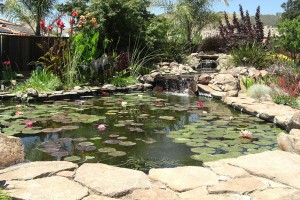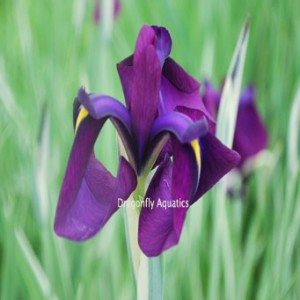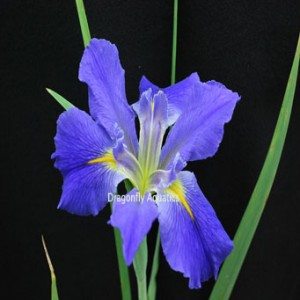I'm not certain of the identity of this butterfly. I thought perhaps it was a male Eastern Tiger Swallowtail. I'm really not certain, although it sure liked my dwarf crab-apple tree. It came back day after day.....I'm thinking it was the same one.
I know we don't want to think about it but it won't be long and fall will be here and we all know what comes next.....its time for us to be thinking about taking the extra care with our pond plants to make them comfortable for the winter cold. I've noticed the butterflies aren't as plentiful as they had been but occassionally I'm able to catch one.
HARDY BOG/MARGINAL PLANTS
Once your hardy marginal plants begin to brown, usually after the first hard frost, prune back excess foliage and discard any decaying material, so it does not compromise the water quality over the winter months. Potted bog plants such as Pickeral, Thalia Dealbata, and Japanese Variegated Iris should be placed at a sufficient depth to avoid freezing the crown of the plant. Most of the other hardy bog plants can be left as they are and will return the following spring.
Tropical Bog Plants
Many of the tropical bog plants will winter well indoors in a sunny window or with a grow light. They do not need to be submerged in water. Keep the soil constantly moist by placing the potted plants in a tray of water.
There are iris of almost any color one would want.....of course I want to plant them all around the pond. Although they only bloom once during the season I anxiously await their blooms. The Colorific is exactly like its name...blending of colors and quite unique. This plant only had about three flowers on it this year since it was just planted but next year will have more.
Then there is the Clyde Redmond which blooms a little later in the season. Its nice to have different iris blooming at different times of the season. The Wedgwood blue color of this iris adds alot to the pond.
Other than dividing the iris in the early spring they require little care and the rewards of color in your pond are worth it.
 We have alot of plants on sale now so check them out at our store. You still have time to get them planted and established before the cold weather hits us. We're all enjoying our ponds now and the hard labor we've all put into it this spring. We get alot of our customers pictures of their ponds in full bloom which we enjoy. This picture is of a customer's pond in California. We keep trying different night blooming lilies to get them to winter over for her but haven't been real successful. It just gets alittle too cold over the winter for it to survive so this year she's going to try a pond heater and see if it winters over for her that way. All the other plants are doing great! Which is always good to hear.
We have alot of plants on sale now so check them out at our store. You still have time to get them planted and established before the cold weather hits us. We're all enjoying our ponds now and the hard labor we've all put into it this spring. We get alot of our customers pictures of their ponds in full bloom which we enjoy. This picture is of a customer's pond in California. We keep trying different night blooming lilies to get them to winter over for her but haven't been real successful. It just gets alittle too cold over the winter for it to survive so this year she's going to try a pond heater and see if it winters over for her that way. All the other plants are doing great! Which is always good to hear.
 Once your hardy marginal plants begin to brown, usually after the first hard frost, prune back excess foliage and discard any decaying material, so it does not compromise the water quality over the winter months. Potted bog plants such as Pickerel, Thalia Dealbata, and Japanese Variegated Iris should be placed at a sufficient depth to avoid freezing the crown of the plant. Most of the other hardy bog plants can be left as they are and will return the following spring.
Once your hardy marginal plants begin to brown, usually after the first hard frost, prune back excess foliage and discard any decaying material, so it does not compromise the water quality over the winter months. Potted bog plants such as Pickerel, Thalia Dealbata, and Japanese Variegated Iris should be placed at a sufficient depth to avoid freezing the crown of the plant. Most of the other hardy bog plants can be left as they are and will return the following spring.
 All irises will perform well if they are given at least six hours of sunlight. Most irises will not flower if the sunlight drops to less than four hours a day. If you do plant an iris in a partially shaded area of your pond the best sunlight is that of the morning rather than the afternoon sun. This will help evaporate the dew from the leaves preventing the risk of fungus or bacteria. If given too much afternoon sun it can burn up the petals of the lighter irises.
All irises will perform well if they are given at least six hours of sunlight. Most irises will not flower if the sunlight drops to less than four hours a day. If you do plant an iris in a partially shaded area of your pond the best sunlight is that of the morning rather than the afternoon sun. This will help evaporate the dew from the leaves preventing the risk of fungus or bacteria. If given too much afternoon sun it can burn up the petals of the lighter irises.
When you first plant a young iris they require less water until they become established, moist soil, little to no water above the soil line. Since an iris is considered a marginal pond plant it is best to plant around the perimeter of your pond or bog area. Most iris will tolerate a range of water depths from moist soil to a few inches of water over their crown once they have become established water plants. Just make sure the crown of the iris always remains moist or in the water. The water garden irises benefit greatly from early spring fertilizer and fertilizing throughout the growing season. You should begin fertilizing irises when the pond temperature reaches 65 degrees and continue to feed them once a month through the growing season, well after they begin to sprout. You can stop fertilizing them about a month before the last frost free date in your area. This will allow the iris to harden off for the winter. If you have no frost in your area stop fertilizing when the plant begins to show signs of going dormant. This would be when the leaves begin to brown and new growth has stopped.
Depending on the iris you have determines the winter care for it. Once the foliage dies back and the water temperatures begin to cool down you can trim the leaves back to about an inch or two above the crown of the plant. You want to make sure they will stay wet throughout the winter. They do best just by leaving them on the shelf of your pond or marginal area of your pond. The main goal is to make sure the iris stays moist throughout the winter. If you do remove the irises from your pond during the winter months where temperatures don't drop below 25 degrees, make sure you don't let them dry out. You can place them in a container filled with 1-4 inches of water or enough water to keep their crowns above the water level.
Buy iris,marginal bog plants here.
I just wanted to let you know that I have already received my Louisiana Irises and they look great. The roots are still wet and the plants are green and healthy. I have already planted them and it is so nice to have a good 12" of growth right out of the box.
Thank you